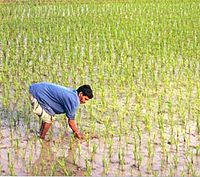
Photo from wikipedia
In this study, total petroleum hydrocarbon (TPH) removal from fuel-contaminated field soil was investigated. The influence of the washing method (washing before/after sieving), washing time, soil-to-water ratio, and soil particle… Click to show full abstract
In this study, total petroleum hydrocarbon (TPH) removal from fuel-contaminated field soil was investigated. The influence of the washing method (washing before/after sieving), washing time, soil-to-water ratio, and soil particle size on TPH removal efficiency was evaluated under constant stirring speed. Washing the whole contaminated soil is more efficient than separating the soils into particle size fractions and separately washing the fractions. Particles with differing diameters would be more in contact with each other resulting in detachment of contaminants from the soil particle surface. Effects of soil washing time and soil-to-water ratio on TPH removal were not significant in coarse soil particles (greater than 0.15 mm diameter) but significantly affected TPH removal in fine particles (less than 0.15 mm diameter). This study suggests a threshold washing time of 1 h and a threshold soil-to-water ratio of 1:6 for the whole soil in soil washing. However, soil particles less than 0.075 mm (<75 μm) should be separated after washing to meet the Korean soil TPH limit of less than 500 mg/kg. This study demonstrates the importance of finer soils as debrading media and particle size fraction composition of fuel-contaminated soil in soil washing.
Journal Title: Chemosphere
Year Published: 2020
Link to full text (if available)
Share on Social Media: Sign Up to like & get
recommendations!